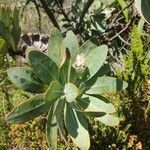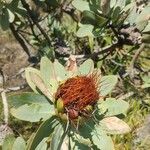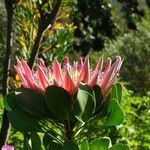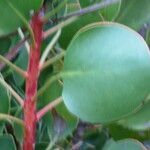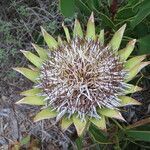Upright shrub, 0.3-2 m in height, with several massive erect (rarely sprawling), simple or only very sparsely branched stems, arising from a persistent subterranean lignotuber. Stems 5-15 mm in diam., glabrous, stout and heavy. Leaves glabrous, petiolate, 120-300 mm long, petiole 40-180 mm long, blade round, oval or elliptic, 20 to 130 mm wide, 80-140 mm long, thickly cartilaginous to heavily coriaceous. Inflorescence narrowly goblet-shaped to shallowly bowl-shaped, 120-200 mm long, 120-300 mm in diam. Involucral receptacle broadly conic-acute, 20-50 mm in diam., 15-45 mm high. Involucral bracts 5-10 seriate, loosely or tightly imbricate, sparsely to very densely sericeous to velutinous, occasionally quite glabrous; outer series narrowly lanceolate-acuminate to broadly ovate-acute, 7-25 mm wide, 20-40 mm long; inner series narrowly to broadly lanceolate, occasionally oblong, 80-120 mm long, 10-35 mm wide, apices acute, acuminate or occasionally rounded and concave; innermost series widely splayed to imbricate. Perianth 70-100 mm long, tube and claws straight, limbs strongly adaxially arcuate; tube region glabrous on outer surface, blackening, merging imperceptibly with claws and becoming puberulous distally, inner surface densely puberulous; limbs linear-acuminate, 20-35 mm long, very densely velutinous to villous, abaxial limb shorter than 3 adaxial limbs, each limb terminating in a cartilaginous awn. Anthers 4, sub-sessile. Style 80-95 mm long, straight, ancipitous and sparsely puberulous proximally, becoming incurved, terete and glabrous distally. Pollen presenter linear-subulate, 10-15 mm long, quadrangularly ridged, prominently geniculate at junction with style. Ovary obconic, 5 mm long, covered with 15 mm long, straight trichomes, white initially becoming black on mature fruits. Hypogynous scales oval to ovate, 2 mm long. Time of flowering is a further complicating factor. This is specific for each population and is a genetically stable, inherited character, yet even closely adjacent localities have variants flowering at different times.
More
Shrub, lignotuberous, multiple stems, erect, not branched, 0.3-2.0 m high. Leaves petiolate, round, oval or elliptic, 120-300 x 20-130 mm, coriaceous, glabrous. Flower head conical to bowl-shaped, 120-200 x 120-300 mm. Involucral bracts 5-10-seriate, cream-coloured to crimson, imbricate, glabrous to hairy; outer series lanceolate-acuminate, 20-40 x 7-25 mm; inner series lanceolate, acute, 80-120 x 10-35 mm. Flowers 70-100 mm long, yellow with white awns; style 55-70 mm long, straight, base hairy; pollen presenter 7-10 mm long, thread-like, bent at base. Flowering time all year.
Resprouting shrub to 3 m. Leaves long-petiolate, elliptic to rhomboid. Flower heads large, obconic to cup-shaped, 120-300 mm diam., involucral bracts pale or deep pink, often silky outside, style 80-95 mm long.
A shrub. The leaves are oval or round with leaf stalks 4-18 cm long. The flower heads are 18-30 cm across. They are pink. The bracts are covered with fine hairs.
